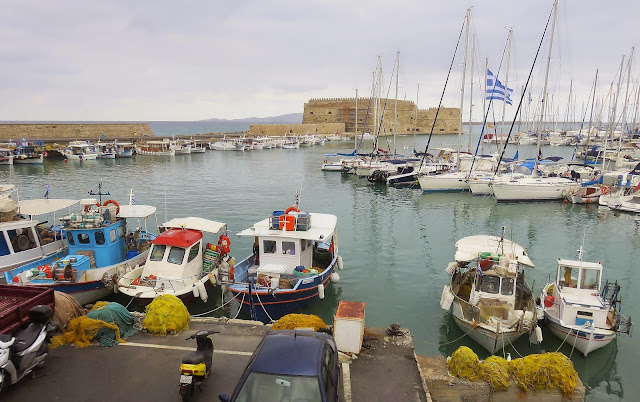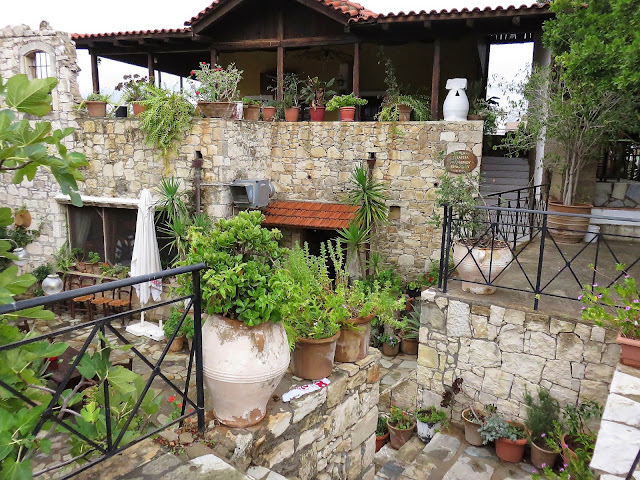Our port was Aghios Nilolaos, (Saint Nicholas). This was our first experience with a tendered stop.
We boarded our tour bus at 9:30 for an all day tour of the island. The island is mountainous, but much of it is in cultivation. There are huge olive groves, citrus, pomegranates, bananas in plastic green houses, and Carob trees.
Local fruits on display at Knossos.
Our first, and most important stop of the day was the archaeological site at Knossos, the palace of King Minos, whose name was given to the Minoans, the first advanced civilization in Europe, peaking about 1950 B.C., and pre-dating the Greeks.
This site was discovered in the late 1800's and has only been worked since 1900. Reconstruction has been done based on the ground level ruins found there.
The double headed axe is a labrys, symbol of the Minoan king, and the origin of the word labyrinth.
There is evidence of the system of running water and sewage systems they had here.
Their buildings were richly decorated with frescoes, some of which have been recreated here, based on archaeological finds.
The bull was revered, and horn symbols adorned the palace. The myth of Minos and the Minotaur, where sacrificial youth were set loose in the labyrinth, to be eaten by the Minotaur ( Minos Bull) are probably just that, myths, but Minos was most probably a true leader, mentioned by Homer as being wise. His power came from economics, not military might, and for a period the Minoans dominated the Greek mainland.
They worshiped the Mother Goddess, and women were very important in their society. Our guide Irene, pronounced ee-ree-nee, explained the significance of what we were seeing.
Very old floors.
Reconstructed throne room.
Water storage. In the valley below, a river supplied the necessary water to support this city.
Then abruptly, in 1450 B.C., this civilization collapsed and disappeared, palaces deserted. Why? Perhaps it was the Santorini volcano. Perhaps it was this volcanic peak nearby. At any rate the Minoans were overcome by the Mycenaeans from the mainland, which in turn provided the foundation for the later Greek civilization.
Tour guides can be long winded about their passions and island bus tours can seem endless, but it is a way to get around to see and to learn.
Next we drove to Heraklion City to see the harbor and the Venetian fortifications there. Rain squalls obstructed the view.
It's not all Greek to me :-)
Finally we drove up into the hills to Arolithos, a cultural center, a place where buildings have been collected or reconstructed to show the culture of Crete.
There we had an amazing Greek dinner, as the plates just kept coming. I counted five small plates- pickled red peppers, hard local cheese, stuffed grape leaves, filo dough wrapped goat cheese, sausage, all local, a mild red wine, Greek salad, all before the main course of chicken and potatoes roasted in olive oil. Dessert was honey soaked cheese tarts, and there was a fruit plate that we ran out of time for. I did get a chance to taste ouzo. It tasted like fire.
And there was entertainment, Creten music and dancing. It was all pretty cool.
We had a few minutes to walk through the "village".
Back on the bus we wound our way back around the island and stopped at an overlook to see the island of Spinalonga, which had one been a leper colony.
Back in St. Nicholas, we had about a half hour of free time before we had to get back to the ship. Free time feels good after being "captive" all day. We saw this carob pod street tree.
And we did a little shopping.
I bought an olive wood necklace for myself and two scarves for Irene.
We walked along this little fresh water lake just next to the harbor.
And then we took the tender back to the ship.





































Looks like lots of uphill walking! I am certain I wouldn't like organized tours. Lots of ruins there...lots of history:)
ReplyDeleteSuch a sense of history--the overwhelming span of it--you must get in visiting these ancient places.
ReplyDeleteI've never been to Crete, but now I'd love to go!
ReplyDeleteYour meal sounds delicious!
ReplyDeleteCan't help but wonder if you slept well after seeing so much beauty, so many things. My head would be spinning. I love seeing your pictures.
ReplyDeleteThat was a very long and active day! I for one enjoy the photos and description.
ReplyDeleteIt was much more relaxing to visit Crete through your pictures than to have walked around all day as a captive. It was very interesting! Thank you. :-)
ReplyDelete